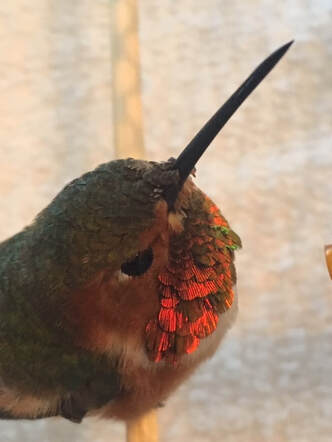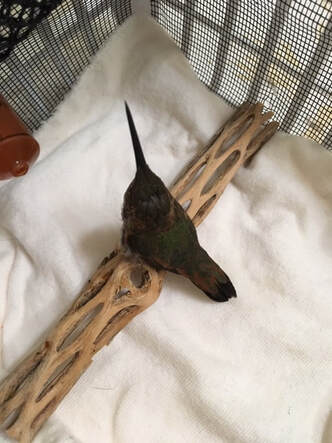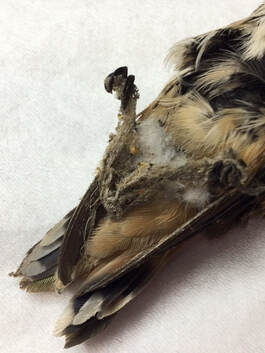ADULTS
Fully feathered, 2-3 inches big, including a beak that is at least an inch long. Colors are more vibrant, usually with orange, magenta or purple at the throat (gorget). Males are more colorful than females. They are wild and if you can hold it, there is a problem. A hummingbird that you can pick up (with the exception of a fledgling) needs to go to a rehabber.
An adult on the ground is there for the following reasons: hurt, sick, exhausted, or dead.
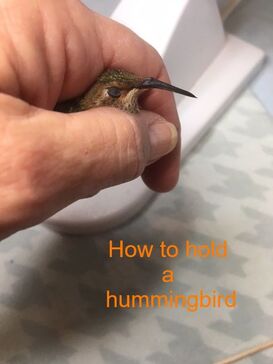
If you find one on the ground, it is usually cold. The two most common reasons they are hurt, is from hitting a window or being caught by a cat. (I'll withhold my usual rant about outdoor cats, but will cover that topic in the FAQs tab). They can also get hit by cars and bicycles, attacked by other hummingbirds, get caught in glue traps and in spider webs.
The best thing to do is to pick it up and hold it in your clean, dry, warm hand, with only the beak sticking out. Hold for 10 minutes, and once it starts getting wiggly, and the eyes are mostly open, you can attempt to give it some sugar water. DO NOT RELEASE IT, even if it's active. It still needs help. If you release a bird that is cold and weak, even if it can fly a little, it won't have the strength to find food or to thermoregulate (stay warm by itself).
Prepare sugar water (one handed if you have no help). 1 part white table sugar (not honey, not saccharine, not aspartame, not brown sugar) to 4 parts tap water room temperature. It is best to dip a q-tip in the sugar water and put to the tip of the bird's beak and let it lick it off. Hurt birds, as they are rewarming don't have much sense, so they will gulp the food until it bubbles out of the sides of their mouths and then it goes into their lungs, and then they aspirate and can die. Only offer a little at a time. Once the bird is warm and fed, prepare a box for it, shoe boxes work well. Soft padding (tee shirt material, cloth diaper, or tea towel as lining). Do not use towels with loops because their little toes get caught in it. Bunch it a little so bird can hold onto material, don't leave it flat. They have rounded feet and need to perch. Cover box with a lid with holes. It is important to keep it warm. You can use a heating pad on low and wrap it around the box, or put 1 cup of dry rice in a sock, in the microwave for 1 minute. Cover with a towel and put it in the box with the bird. When feeding, cover the box with a towel and peek to see where the bird is, then gently pick it up. They will fly, if they can, if you just open the lid. Always be in the bathroom when you open the box to feed, in case the bird can fly a little. This way you don't have a hurt flighted bird in your skylight. Keep it warm (rewarm sock every hour or so) until you can get it to a rehabber.
Never use an open container of sugar water for a hummingbird. If and when the sugar water gets on their feathers, they ruin the feathers, which then fall out, leaving the bird no longer water proof.
Find a rehabber. If the wing is hurt, the bird won't be able to fly well. If the back is injured, it may fly, but only fly a short distance, or low to the ground.
If the beak is broken, or it's breathing is labored and you can catch it, call a rehabber.
If it's a head injury (concussion), the bird may fly really well, but can't think straight. It will fly and fly and fly, and not know to eat, or how to avoid a predator. These birds usually die if they are released. It takes days for them to regain their senses. If you have ever hit your head real hard, you might remember you were nauseated, dizzy, confused and sleepy. They are all these things so cannot protect themselves or remember to feed. These birds have the best prognosis if they get to a rehabber.
If it is caught in a glue trap, saturate the glue area with corn meal (to limit further glue contact), put the trap and bird in a box, warm it, feed it a little and contact a rehabber.
If it is covered with spider webs, contact a rehabber for advice.
Once bird is warm, fed, in a box, look for a rehabber. If you are in or near Orange County, click on the "Contact" tab. If you are not local, there are other links that will help you locate someone to help.
The best thing to do is to pick it up and hold it in your clean, dry, warm hand, with only the beak sticking out. Hold for 10 minutes, and once it starts getting wiggly, and the eyes are mostly open, you can attempt to give it some sugar water. DO NOT RELEASE IT, even if it's active. It still needs help. If you release a bird that is cold and weak, even if it can fly a little, it won't have the strength to find food or to thermoregulate (stay warm by itself).
Prepare sugar water (one handed if you have no help). 1 part white table sugar (not honey, not saccharine, not aspartame, not brown sugar) to 4 parts tap water room temperature. It is best to dip a q-tip in the sugar water and put to the tip of the bird's beak and let it lick it off. Hurt birds, as they are rewarming don't have much sense, so they will gulp the food until it bubbles out of the sides of their mouths and then it goes into their lungs, and then they aspirate and can die. Only offer a little at a time. Once the bird is warm and fed, prepare a box for it, shoe boxes work well. Soft padding (tee shirt material, cloth diaper, or tea towel as lining). Do not use towels with loops because their little toes get caught in it. Bunch it a little so bird can hold onto material, don't leave it flat. They have rounded feet and need to perch. Cover box with a lid with holes. It is important to keep it warm. You can use a heating pad on low and wrap it around the box, or put 1 cup of dry rice in a sock, in the microwave for 1 minute. Cover with a towel and put it in the box with the bird. When feeding, cover the box with a towel and peek to see where the bird is, then gently pick it up. They will fly, if they can, if you just open the lid. Always be in the bathroom when you open the box to feed, in case the bird can fly a little. This way you don't have a hurt flighted bird in your skylight. Keep it warm (rewarm sock every hour or so) until you can get it to a rehabber.
Never use an open container of sugar water for a hummingbird. If and when the sugar water gets on their feathers, they ruin the feathers, which then fall out, leaving the bird no longer water proof.
Find a rehabber. If the wing is hurt, the bird won't be able to fly well. If the back is injured, it may fly, but only fly a short distance, or low to the ground.
If the beak is broken, or it's breathing is labored and you can catch it, call a rehabber.
If it's a head injury (concussion), the bird may fly really well, but can't think straight. It will fly and fly and fly, and not know to eat, or how to avoid a predator. These birds usually die if they are released. It takes days for them to regain their senses. If you have ever hit your head real hard, you might remember you were nauseated, dizzy, confused and sleepy. They are all these things so cannot protect themselves or remember to feed. These birds have the best prognosis if they get to a rehabber.
If it is caught in a glue trap, saturate the glue area with corn meal (to limit further glue contact), put the trap and bird in a box, warm it, feed it a little and contact a rehabber.
If it is covered with spider webs, contact a rehabber for advice.
Once bird is warm, fed, in a box, look for a rehabber. If you are in or near Orange County, click on the "Contact" tab. If you are not local, there are other links that will help you locate someone to help.
Recap - identify there's a problem, warm him in your hand, prepare a home made incubator, feed small amounts of sugar water after he is warm and find a rehabber. ALWAYS OPEN THE BOX IN A BATHROOM. IN CASE THEY FLY A LITTLE. If you suspect they might be flighted, cover the window and mirror so they don't hurt themselves. Open the box on the ground so that they have a shorter fall.
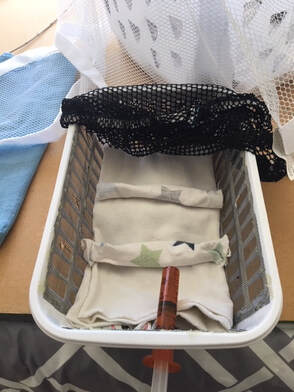
Box must have soft sides, no large holes for escape, a way to get air and a lid. I use a mesh lid so I can see the bird, but it cannot escape. I cover the box with a light towel so the bird doesn't stress. You can suspend a syringe or an eyedropper with sugar water until you get to a rehabber (after confirming that the bird is self feeding). Do not leave an open container of sugar water (not even a cap full). A hurt, scared bird will end up with sugar water on it's feathers, which causes them to fall out if it is not cleaned off quickly. This makes them unreleasable due to having areas that they cannot keep warm.
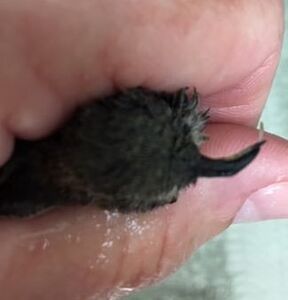
Fledgling with a broken beak. Hit a window while learning to fly.
Proudly powered by Weebly
